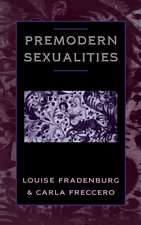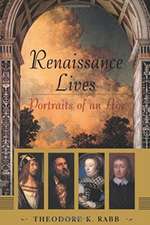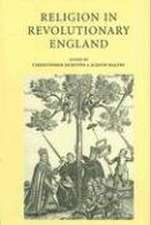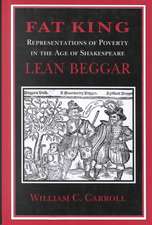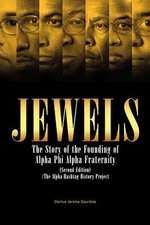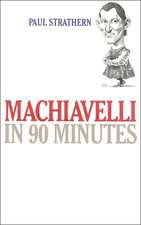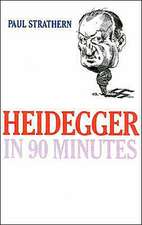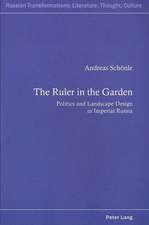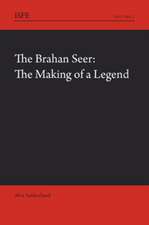The Artist, the Philosopher, and the Warrior: Da Vinci, Machiavelli, and Borgia and the World They Shaped
Autor Paul Strathernen Limba Engleză Paperback – 31 ian 2011
In 1502, Italy was riven by conflict, with the city of Florence as the ultimate prize. Machiavelli, the consummate political manipulator, attempted to placate the savage Borgia by volunteering Leonardo to be Borgia’s chief military engineer. That autumn, the three men embarked together on a brief, perilous, and fateful journey through the mountains, remote villages, and hill towns of the Italian Romagna—the details of which were revealed in Machiavelli’s frequent dispatches and Leonardo’s meticulous notebooks.
Superbly written and thoroughly researched, The Artist, the Philosopher, and the Warrior is a work of narrative genius—whose subject is the nature of genius itself.
Preț: 123.17 lei
Nou
Puncte Express: 185
Preț estimativ în valută:
23.57€ • 24.61$ • 19.51£
23.57€ • 24.61$ • 19.51£
Carte disponibilă
Livrare economică 15-29 martie
Preluare comenzi: 021 569.72.76
Specificații
ISBN-13: 9780553386141
ISBN-10: 055338614X
Pagini: 455
Ilustrații: 8 PP 4-COLOR INSERT & PHOTOS THRU/OUT
Dimensiuni: 136 x 201 x 27 mm
Greutate: 0.37 kg
Editura: Bantam
ISBN-10: 055338614X
Pagini: 455
Ilustrații: 8 PP 4-COLOR INSERT & PHOTOS THRU/OUT
Dimensiuni: 136 x 201 x 27 mm
Greutate: 0.37 kg
Editura: Bantam
Notă biografică
Paul Strathern has lectured in philosophy and mathematics and is a Somerset Maugham Prizeߝwinning novelist. He is the author of two series—Philosophers in 90 Minutes and The Big Idea: Scientists Who Changed the World—Napoleon in Egypt, and the Sunday Times bestseller The Medici: Godfathers of the Renaissance. He lives in London.
From the Hardcover edition.
From the Hardcover edition.
Extras
Chapter One
Leonardo Learning
leonardo da vinci was born in 1452 in the hilly Tuscan country?side near the village of Vinci, some twenty miles west of Florence. He was the illegitimate son of Ser Piero da Vinci, a twenty-six-year-old notary, who during Leonardo's childhood remained for the most part in Florence, pursuing a successful career. All that is known for certain of Leonardo's mother, Caterina, is that she was a twenty-five-year-old peasant girl, who may have been the daughter of a local woodcutter.
Few facts are known about Leonardo's early years and we have to rely upon occasional, often enigmatic, remarks made years later in his notebooks. A prime example is the comment made by Leonardo whilst he was writing on the flight of birds, in this case observing the flight of the fork-tailed kite, a bird that often flew over Vinci from the slopes of nearby Mount Albano:
Writing in such detail about the kite seems to be my destiny, since in the first memory of my childhood it seemed to me that whilst I was lying in my cradle a kite flew down and brushed open my mouth with its tail, and struck me several times with its tail on the inside of my lips.
Out of this suggestive fragment Freud would construct an entire psychological history for Leonardo, leading from the trauma of separ?ation from his mother, and his consequent ambivalent feelings towards her, to his homosexuality and his reluctance to finish projects upon which he embarked. Unfortunately the German translation used by Freud mistakenly rendered the Italian word for kite (nebbio) as "vulture," lending an altogether more lurid tone to this memory. Despite this error, Freud's claim that Leonardo's memory of the tail probing his lips was a masked image of his mother's nipple, when he was suckling her breast, seems plausible enough. And there is little doubt that Leonardo did suffer a trauma on separation from his mother. Years later he would write down a series of riddles, amongst which there is a recurrent theme of violent separation of a mother and her child. A typical example reads: "Many children will be torn from the arms of their mother with pitiless blows and be thrown to the ground to be mutilated." The answer to the riddle is in fact "Nuts, and olives and acorns," but the power of the prior image is suggestive.
In 1456, when Leonardo was four, Tuscany was devastated by a great storm, possibly a tornado. Years later he could still vividly recall:
I have witnessed movements of air so furious that they have borne away, mixed up within them, the largest trees of the forest and the whole roofs of great palaces, and I have seen the same fury bore a hole with its whirling force, digging out a gravel pit, and carrying off gravel, sand and water more than half a mile through the air.
Several years after this, the River Arno would overflow its banks, causing severe floods throughout the Val d'Arno. The power of these two natural disasters that Leonardo experienced in his youth would long remain in his memory, the latter initiating a fearful fascination with deluges and floods that would last throughout his life.
Leonardo was brought up in the household of his paternal grandfather, Antonio da Vinci, where he seems to have become particularly attached to Antonio's youngest son, Francesco, who despite being Leonardo's uncle was just fifteen years older than he. Unlike Leonardo's ambitious father, Francesco had remained behind in the country, where he busied himself looking after the da Vinci farmland and vineyards. We can imagine the impressionable young Leonardo dogging the footsteps of his uncle as he oversaw the laborers on the estate. Francesco was almost certainly the first of the several powerful figures to whom Leonardo would be drawn throughout his life. Significantly, all these figures would be young men: initially older than Leonardo, later younger—but mostly in their twenties, the age of Francesco when the child Leonardo would first have become attached to him. (For example, Cesare Borgia was just twenty-five when the middle-aged Leonardo first encountered him.)
Francesco must have passed on much country lore to his young nephew. The ways of nature—how it appeared, what was happening, what this meant—would remain one of Leonardo's constant preoccupations throughout his life. This curiosity may well have been what initially prompted him to draw.
At least temporarily, Francesco would be the father-figure who was missing from Leonardo's life. During this period the young boy was also virtually motherless, for within a year of his birth Caterina married a returned soldier, not long after which Leonardo seems to have been left largely to his own devices. Far from being lonely, he soon began discovering the joys of solitude, of which he later spoke so warmly: "While you are alone you are completely yourself; and if you are accompanied by even one other person you are but half yourself." This solitude was from the beginning associated with drawing nature: "You should say to yourself, 'I will go my own way and withdraw apart from others, the better to study the form of natural objects.'" Years later he would recall an occasion when he was walking alone in the countryside:
Driven by my eager desire and wishing to see the multitude of varied and strange forms created by nature, and having wandered some distance amongst overhanging rocks, I came to the entrance of a great cavern, in front of which I stood for some time, astonished, having never seen such a thing before. Bending forward, I rested my tired hand on my knee and held my right hand above my furrowed eyebrows as I peered down. I shifted from side to side, to see whether I could discern anything inside, but this was prevented by the deep darkness within. After having remained there for some time, I felt the contrary emotions of fear and desire arising within me—fear of the forbidding dark cavern, and my desire to see whether there was anything marvelous within it.
This description exhibits a riveting particularity—one can vividly picture the young Leonardo amongst the rocks, leaning on his knee, peering forward in the bright sunlight. Yet at the same time he consciously introduces elements that allude to something more: his desires, his fears, the very nature of his individuality. It is as if Leonardo is prompting us to read this passage imaginatively, as one might read an occasional poem. Under such circumstances we become aware of the sexual undertones of the cave and the primeval fear of the unknown that lurks in the darkness, as well as the longing to discover the "marvelous" truth of that very same unknown.
Soon, of course, curiosity overcame Leonardo's fears and he entered the darkness of his metaphorical cave to explore its secrets. Such curiosity suffused his dreams, which included great and strange ambitions. Later, in one of his riddles, he would describe dreaming in the following words, which reek of subjective experience:
Men will seem to see unknown destructions in the sky. It will seem that they are flying up into the sky, and then they are fleeing in terror from the flames that pour down on them. They will hear animals of every kind speaking in human language. Their bodies will glide in an instant to various parts of the world without moving. They will see the greatest splendors in the midst of the darkness. What a marvel is the human race! What frenzy has led you to this? . . . You will see yourself falling from great heights without harming yourself. Torrents will sweep you along and whirl you in their rapid course. . . .
It is as if we are seeing Leonardo's future ambitions in embryo, and yet these are the very dreams we all experience. Leonardo's life would be spent trying to realize the dreams of humanity itself. He remained deeply attuned to the promptings of his unconscious mind—its wish to fly, to understand the secrets of nature, to survive a torrent of water. Instead of being taught what to do, what to think, he dreamed of what he wanted to do, and no formal schooling persuaded him otherwise.
Leonardo's father, Ser Piero, would certainly have visited his own father, Antonio da Vinci, and his brother, Francesco, at the da Vinci estate for feast-day family gatherings and during longer summer holidays. And he would of course have brought along his young wife, Albiera, whom he had married in Florence, just as he would bring along his second wife, Francesca, whom he married when Albiera died. Both of these women remained childless. Leonardo may have been a lone motherless child, but it appears that his growing good looks and precocious skill in drawing charmed both his childless stepmothers. From the beginning, he exhibited the self-certainty of one who is used to being the center of attention, of a boy who has grown up experiencing worshipful and unquestioning female love. The fact that both these adoring stepmothers would die when he was still young doubtless caused him sorrow, and may have contributed to the reserved self-possession that he began to display.
Around the mid-1460s, at the beginning of Leonardo's adolescence, he went to live in Florence, where his exceptional talent for drawing enabled him to become apprenticed to the studio of the leading artist Andrea del Verrocchio. Here Leonardo would learn drawing, painting, anatomy, sculpting, and architectural design. This led him into new fields, extending his intellect even further. Drawing would lead him to the study of perspective, which then interested him in geometry; anatomy would lead him to ponder the workings of mechanical devices; architecture would lead him to a study of arithmetic proportions; and this would in turn lead him to learn about harmony in music. His intellectual curiosity coupled with his lack of formal education prompted him to an endless quest for new knowledge. But this would be knowledge that he insisted upon acquiring in his own way: not from books (most of which were written in Latin, which he could not understand), but from experience; not systematically, but as and when the appropriate opportunity presented itself. He began jotting things down in notebooks, without overall order or consequence, just as he would throughout his life. There was no encompassing plan beyond the pure initial impulse, which led with childlike power and wonder in its own direction. Yet his education was not entirely without book learning. It was at around this period that he started reading, in Italian translation, the first-century bc Roman author Lucretius, whose epic poem De Rerum Natura (On the Nature of Things) sought to explain the world in scientific terms. Although Leonardo's investigations may have appeared serendipitous, they were increasingly guided by an overall vision, a consistent empirical view of the world, and this he probably drew from Lucretius.
Many of Florence's finest artists would gather at Verrocchio's studio, including Botticelli, the favorite painter of Lorenzo the Magnificent, head of the powerful Medici family that ruled Florence. Lorenzo's "magnificence" extended into many fields. As a ruler he would make Florence great; his bravery in jousting was legendary; he was one of the most accomplished poets of his time, and the circle he maintained at the Palazzo Medici on the Via Larga included the finest poets, artists, philosophers, and scholars. Amongst these were the poet Angelo Poliziano, the philosopher Giovanni Pico della Mirandola, and the Platonic scholar Marsilio Ficino, all leading luminaries of the Renaissance that was taking place in Florence.
Inevitably, it was not long before the handsome and talented Leonardo da Vinci came to the attention of Lorenzo the Magnificent. Here was another powerful young man to whom Leonardo would find himself drawn, and Leonardo would soon be regarded as part of Lorenzo's circle of artists, philosophers, and poets. In the course of his musical studies Leonardo had learned to play the lyre and had devel-oped an exceptionally harmonious singing voice, with which he would now entertain Lorenzo and his friends. This personal connection with the city's ruler was to have serious consequences for Leonardo. Partly in self-conscious assertion of his own exceptional abilities, and partly in bravura compensation for his illegitimacy, Leonardo had developed into something of a dandy. Tall and handsome, he cut a fine figure striding through the streets of Florence in his thigh-length boots of soft Cordoba leather, his long hair falling in curls about the shoulders of his short pink tunic, his passing presence wreathed in rose-water scent.
In April 1476 Leonardo was denounced, along with three others, in an anonymous note to the authorities claiming that he had practiced sodomy with a young man called Jacopo Saltarelli. As a result Leonardo was charged, and almost certainly spent some time in the cells, before being released pending a trial in two months' time. The charges were finally dropped after a word to the authorities from Lorenzo the Magnificent. The accus?ation against Leonardo appear to have been engineered by one or other of the powerful families who resented Medici rule, as an attempt to discredit Lorenzo and his circle.
It was a deeply humiliating episode, yet the only evidence we have of Leonardo's feelings is characteristically oblique and ingenious. Amongst his drawings from around this period there is a sketch of one of his earliest inventions—a powerful and meticulously drawn "design for a device for unhinging a prison door from the inside." One can but imagine him sitting in his soiled finery in the dimness of his cell amidst the stinking vermin-ridden straw, bitterly piecing together in his mind a machine that would have enabled him to escape.
From the Hardcover edition.
Leonardo Learning
leonardo da vinci was born in 1452 in the hilly Tuscan country?side near the village of Vinci, some twenty miles west of Florence. He was the illegitimate son of Ser Piero da Vinci, a twenty-six-year-old notary, who during Leonardo's childhood remained for the most part in Florence, pursuing a successful career. All that is known for certain of Leonardo's mother, Caterina, is that she was a twenty-five-year-old peasant girl, who may have been the daughter of a local woodcutter.
Few facts are known about Leonardo's early years and we have to rely upon occasional, often enigmatic, remarks made years later in his notebooks. A prime example is the comment made by Leonardo whilst he was writing on the flight of birds, in this case observing the flight of the fork-tailed kite, a bird that often flew over Vinci from the slopes of nearby Mount Albano:
Writing in such detail about the kite seems to be my destiny, since in the first memory of my childhood it seemed to me that whilst I was lying in my cradle a kite flew down and brushed open my mouth with its tail, and struck me several times with its tail on the inside of my lips.
Out of this suggestive fragment Freud would construct an entire psychological history for Leonardo, leading from the trauma of separ?ation from his mother, and his consequent ambivalent feelings towards her, to his homosexuality and his reluctance to finish projects upon which he embarked. Unfortunately the German translation used by Freud mistakenly rendered the Italian word for kite (nebbio) as "vulture," lending an altogether more lurid tone to this memory. Despite this error, Freud's claim that Leonardo's memory of the tail probing his lips was a masked image of his mother's nipple, when he was suckling her breast, seems plausible enough. And there is little doubt that Leonardo did suffer a trauma on separation from his mother. Years later he would write down a series of riddles, amongst which there is a recurrent theme of violent separation of a mother and her child. A typical example reads: "Many children will be torn from the arms of their mother with pitiless blows and be thrown to the ground to be mutilated." The answer to the riddle is in fact "Nuts, and olives and acorns," but the power of the prior image is suggestive.
In 1456, when Leonardo was four, Tuscany was devastated by a great storm, possibly a tornado. Years later he could still vividly recall:
I have witnessed movements of air so furious that they have borne away, mixed up within them, the largest trees of the forest and the whole roofs of great palaces, and I have seen the same fury bore a hole with its whirling force, digging out a gravel pit, and carrying off gravel, sand and water more than half a mile through the air.
Several years after this, the River Arno would overflow its banks, causing severe floods throughout the Val d'Arno. The power of these two natural disasters that Leonardo experienced in his youth would long remain in his memory, the latter initiating a fearful fascination with deluges and floods that would last throughout his life.
Leonardo was brought up in the household of his paternal grandfather, Antonio da Vinci, where he seems to have become particularly attached to Antonio's youngest son, Francesco, who despite being Leonardo's uncle was just fifteen years older than he. Unlike Leonardo's ambitious father, Francesco had remained behind in the country, where he busied himself looking after the da Vinci farmland and vineyards. We can imagine the impressionable young Leonardo dogging the footsteps of his uncle as he oversaw the laborers on the estate. Francesco was almost certainly the first of the several powerful figures to whom Leonardo would be drawn throughout his life. Significantly, all these figures would be young men: initially older than Leonardo, later younger—but mostly in their twenties, the age of Francesco when the child Leonardo would first have become attached to him. (For example, Cesare Borgia was just twenty-five when the middle-aged Leonardo first encountered him.)
Francesco must have passed on much country lore to his young nephew. The ways of nature—how it appeared, what was happening, what this meant—would remain one of Leonardo's constant preoccupations throughout his life. This curiosity may well have been what initially prompted him to draw.
At least temporarily, Francesco would be the father-figure who was missing from Leonardo's life. During this period the young boy was also virtually motherless, for within a year of his birth Caterina married a returned soldier, not long after which Leonardo seems to have been left largely to his own devices. Far from being lonely, he soon began discovering the joys of solitude, of which he later spoke so warmly: "While you are alone you are completely yourself; and if you are accompanied by even one other person you are but half yourself." This solitude was from the beginning associated with drawing nature: "You should say to yourself, 'I will go my own way and withdraw apart from others, the better to study the form of natural objects.'" Years later he would recall an occasion when he was walking alone in the countryside:
Driven by my eager desire and wishing to see the multitude of varied and strange forms created by nature, and having wandered some distance amongst overhanging rocks, I came to the entrance of a great cavern, in front of which I stood for some time, astonished, having never seen such a thing before. Bending forward, I rested my tired hand on my knee and held my right hand above my furrowed eyebrows as I peered down. I shifted from side to side, to see whether I could discern anything inside, but this was prevented by the deep darkness within. After having remained there for some time, I felt the contrary emotions of fear and desire arising within me—fear of the forbidding dark cavern, and my desire to see whether there was anything marvelous within it.
This description exhibits a riveting particularity—one can vividly picture the young Leonardo amongst the rocks, leaning on his knee, peering forward in the bright sunlight. Yet at the same time he consciously introduces elements that allude to something more: his desires, his fears, the very nature of his individuality. It is as if Leonardo is prompting us to read this passage imaginatively, as one might read an occasional poem. Under such circumstances we become aware of the sexual undertones of the cave and the primeval fear of the unknown that lurks in the darkness, as well as the longing to discover the "marvelous" truth of that very same unknown.
Soon, of course, curiosity overcame Leonardo's fears and he entered the darkness of his metaphorical cave to explore its secrets. Such curiosity suffused his dreams, which included great and strange ambitions. Later, in one of his riddles, he would describe dreaming in the following words, which reek of subjective experience:
Men will seem to see unknown destructions in the sky. It will seem that they are flying up into the sky, and then they are fleeing in terror from the flames that pour down on them. They will hear animals of every kind speaking in human language. Their bodies will glide in an instant to various parts of the world without moving. They will see the greatest splendors in the midst of the darkness. What a marvel is the human race! What frenzy has led you to this? . . . You will see yourself falling from great heights without harming yourself. Torrents will sweep you along and whirl you in their rapid course. . . .
It is as if we are seeing Leonardo's future ambitions in embryo, and yet these are the very dreams we all experience. Leonardo's life would be spent trying to realize the dreams of humanity itself. He remained deeply attuned to the promptings of his unconscious mind—its wish to fly, to understand the secrets of nature, to survive a torrent of water. Instead of being taught what to do, what to think, he dreamed of what he wanted to do, and no formal schooling persuaded him otherwise.
Leonardo's father, Ser Piero, would certainly have visited his own father, Antonio da Vinci, and his brother, Francesco, at the da Vinci estate for feast-day family gatherings and during longer summer holidays. And he would of course have brought along his young wife, Albiera, whom he had married in Florence, just as he would bring along his second wife, Francesca, whom he married when Albiera died. Both of these women remained childless. Leonardo may have been a lone motherless child, but it appears that his growing good looks and precocious skill in drawing charmed both his childless stepmothers. From the beginning, he exhibited the self-certainty of one who is used to being the center of attention, of a boy who has grown up experiencing worshipful and unquestioning female love. The fact that both these adoring stepmothers would die when he was still young doubtless caused him sorrow, and may have contributed to the reserved self-possession that he began to display.
Around the mid-1460s, at the beginning of Leonardo's adolescence, he went to live in Florence, where his exceptional talent for drawing enabled him to become apprenticed to the studio of the leading artist Andrea del Verrocchio. Here Leonardo would learn drawing, painting, anatomy, sculpting, and architectural design. This led him into new fields, extending his intellect even further. Drawing would lead him to the study of perspective, which then interested him in geometry; anatomy would lead him to ponder the workings of mechanical devices; architecture would lead him to a study of arithmetic proportions; and this would in turn lead him to learn about harmony in music. His intellectual curiosity coupled with his lack of formal education prompted him to an endless quest for new knowledge. But this would be knowledge that he insisted upon acquiring in his own way: not from books (most of which were written in Latin, which he could not understand), but from experience; not systematically, but as and when the appropriate opportunity presented itself. He began jotting things down in notebooks, without overall order or consequence, just as he would throughout his life. There was no encompassing plan beyond the pure initial impulse, which led with childlike power and wonder in its own direction. Yet his education was not entirely without book learning. It was at around this period that he started reading, in Italian translation, the first-century bc Roman author Lucretius, whose epic poem De Rerum Natura (On the Nature of Things) sought to explain the world in scientific terms. Although Leonardo's investigations may have appeared serendipitous, they were increasingly guided by an overall vision, a consistent empirical view of the world, and this he probably drew from Lucretius.
Many of Florence's finest artists would gather at Verrocchio's studio, including Botticelli, the favorite painter of Lorenzo the Magnificent, head of the powerful Medici family that ruled Florence. Lorenzo's "magnificence" extended into many fields. As a ruler he would make Florence great; his bravery in jousting was legendary; he was one of the most accomplished poets of his time, and the circle he maintained at the Palazzo Medici on the Via Larga included the finest poets, artists, philosophers, and scholars. Amongst these were the poet Angelo Poliziano, the philosopher Giovanni Pico della Mirandola, and the Platonic scholar Marsilio Ficino, all leading luminaries of the Renaissance that was taking place in Florence.
Inevitably, it was not long before the handsome and talented Leonardo da Vinci came to the attention of Lorenzo the Magnificent. Here was another powerful young man to whom Leonardo would find himself drawn, and Leonardo would soon be regarded as part of Lorenzo's circle of artists, philosophers, and poets. In the course of his musical studies Leonardo had learned to play the lyre and had devel-oped an exceptionally harmonious singing voice, with which he would now entertain Lorenzo and his friends. This personal connection with the city's ruler was to have serious consequences for Leonardo. Partly in self-conscious assertion of his own exceptional abilities, and partly in bravura compensation for his illegitimacy, Leonardo had developed into something of a dandy. Tall and handsome, he cut a fine figure striding through the streets of Florence in his thigh-length boots of soft Cordoba leather, his long hair falling in curls about the shoulders of his short pink tunic, his passing presence wreathed in rose-water scent.
In April 1476 Leonardo was denounced, along with three others, in an anonymous note to the authorities claiming that he had practiced sodomy with a young man called Jacopo Saltarelli. As a result Leonardo was charged, and almost certainly spent some time in the cells, before being released pending a trial in two months' time. The charges were finally dropped after a word to the authorities from Lorenzo the Magnificent. The accus?ation against Leonardo appear to have been engineered by one or other of the powerful families who resented Medici rule, as an attempt to discredit Lorenzo and his circle.
It was a deeply humiliating episode, yet the only evidence we have of Leonardo's feelings is characteristically oblique and ingenious. Amongst his drawings from around this period there is a sketch of one of his earliest inventions—a powerful and meticulously drawn "design for a device for unhinging a prison door from the inside." One can but imagine him sitting in his soiled finery in the dimness of his cell amidst the stinking vermin-ridden straw, bitterly piecing together in his mind a machine that would have enabled him to escape.
From the Hardcover edition.
Recenzii
“Using his novelist’s eye and a historian’s sweep, Strathern . . . makes you care deeply for these complex figures.”—The Washington Post Book World
“[A] rigorous and scholarly yet readable study of the confluence of three major Renaissance figures. Accessible and impressive in scope.”—Kirkus Reviews
“Readers will reel at this meticulous popular account of Renaissance tyranny, corruption, injustice and atrocities.”—Publishers Weekly
“This is popular history at its narrative best—rich in colour, character and consequence.”—The Times (London)
“The book breaks new ground.”—San Antonio Express-News
“A triumph.”—The Sunday Telegraph (London)
“[A] rigorous and scholarly yet readable study of the confluence of three major Renaissance figures. Accessible and impressive in scope.”—Kirkus Reviews
“Readers will reel at this meticulous popular account of Renaissance tyranny, corruption, injustice and atrocities.”—Publishers Weekly
“This is popular history at its narrative best—rich in colour, character and consequence.”—The Times (London)
“The book breaks new ground.”—San Antonio Express-News
“A triumph.”—The Sunday Telegraph (London)

